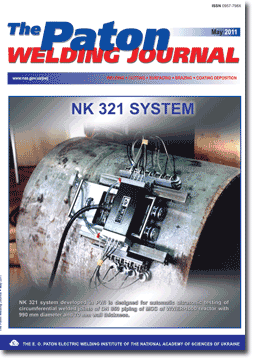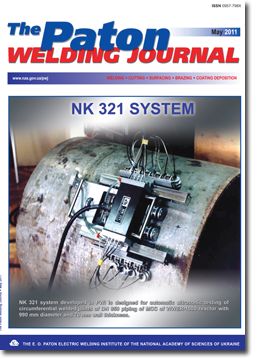| 2011 №05 (01) | 2011 №05 (03) |

The Paton Welding Journal, 2011, #5, 8-12 pages
ON THE SUBJECT OF ELECTRIC SUBMERGED-ARC WELDING
V.G. KUZMENKO
E.O. Paton Electric Welding Institute, NASU, Kiev, Ukraine
Abstract
Results of investigation of the nature of flux melting in electric submerged-arc welding with slag bubble formation are described. It is established that the flux melts without formation of a slag bubble by the gas-plasma flows of the arc in the convective heat exchange mode. These conclusions are confirmed by visual observations of electric arc running under flux, using a procedure specially developed for this purpose. Moreover, an extended plume of liquid slag forms in the post-arc zone, which is separated from the weld metal by a wedge-like layer of solid slag. The process of slag crust formation is also due to high heat-insulating properties of welding fluxes.
Keywords: electric submerged-arc welding, slag bubble, thermophysics, flux heat conductivity, hydrodynamics, visual observation of arcing, process diagram
Received: ??.??.??
Published: 28.05.11
References
1. Kuzmenko, V.G. (1998) About continuity of slag shell in submerged-arc welding. Avtomatich. Svarka, 3, 14-19.
2. Kuzmenko, V.G. (2000) On the features of flux melting in electric arc welding. The Paton Welding J., 11, 57-58.
3. Kuzmenko, V.G. (1999) Features of melting and solidification of flux in electric arc welding. Svarochn. Proizvodstvo, 10, 16-22.
4. Badianov, B.N. (1999) New scheme of submerged-arc welding process. Ibid., 6, 18-29.
5. Ostapenko, N.G., Medovar, B.I. (1947) X-ray analysis of submerged arc zone. Avtogennoe Delo, 11, 16-20.
6. Grebelnik, P.G. (1950) X-ray analysis of automatic submerged-arc welding process. Avtomatich. Svarka, 6, 18-29.
7. Pokhodnya, I.K. (1964) Method of analysis of electrode melting and transport process in welding. Ibid., 2, 1-10.
8. Gobarev, L.A., Mazel, A.G., Shmeleva, I.A. et al. (1973) Analysis of submerged arc in welding using pulse X-ray apparatus. Ibid., 2, 69-70.
9. Eichhorn, F., Dilthey, U. (1971) High-speed X-ray photography for submerged arc welding. Metal Construction and British Welding J., 3(12), 453-456.
10. Kasatkin, A.G. (1973) Processes and apparatuses of chemical technology. Moscow: Khimiya.
11. Kuehling, H. (1982) Reference book on physics. Moscow: Mir.
12. Rykalin, N.N. (1951) Calculations of thermal processes in welding. Moscow: Mashgiz.
13. Litovsky, E.Ya., Puchkelevich, N.A. (1982) Thermophysical properties of refractory materials. Moscow: Metallurgiya.
14. Krzhizhanovsky, R.E., Shtern, Z.Yu. (1973) Thermophysical properties of inorganic materials. Leningrad: Energiya.
15. Misnar, A. (1968) Heat conductivity of solids, liquids, gases and their compositions. Moscow: Mir.
16. Chekhovsky, V.Ya., Ulashchik, A.N. (1987) Heat conductivity of slags in solid and molten states. Teplofizika Vys. Temperatur, 5(5), 924-928.
17. Yavojsky, Ya.I. (1967) Theory of steelmaking processes. Moscow: Metallurgiya.
18. (1964) Steelmaking. Vol. 1. Moscow: Metallurgiya.
19. Sakura, T., Emi, T., Ohata, H. et al. (1982) Determination of heat conductivity of slag melts by modified method of laser beam. Nihon Kinzoku Gakkaisha, 46(12), 1131-1138.
20. Egorov, V.N., Kondratenkov, V.I., Kilesso, V.S. (1972) Thermophysical properties of some glasses and pyroceramics. Teplofizika Vys. Temperatur, 5, 95-99.
21. Serebrennikov, N.I., Geld, P.V. (1968) Enthalpy and temperature of slag melting in aluminothermic fabrication of some ferroalloys. Izvestiya Vuzov. Series Tsvet. Metallurgiya, 4, 39-44.
22. Maurakh, M.A., Mitin, B.S. (1979) Liquid refractory oxides. Moscow: Metallurgiya.
23. Vajsburd, S.E., Zedina, I.N. (1970) Thermal properties of some silicates in liquid state. In: Physical chemistry of molten slags. Kiev: Naukova Dumka.
24. Bobylev, I.B., Anfilogov, V.N. (1983) Method of calculation of molten slag density. Metally, 4, 37-44.
25. Erokhin, A.A. (1979) Force effect of arc on molten metal. Avtomatich. Svarka, 7, 21-26.
26. Chigarev, V.V., Shchetinin, S.V. (2001) Distribution of welding arc pressure. The Paton Welding J., 9, 8-11.
27. Suzdalev, I.V., Yavno, E.I. (1981) Device for analysis of nature of distribution of welding arc force effect. Svarochn. Proizvodstvo, 3, 37-38.
28. Kovalev, I.M., Krichevsky, E.M., Lvov, V.N. (1974) Effect of metal motion in welding pool on arc stability and weld formation. Ibid., 11, 5-7.
29. Mechev, V.S. (1983) Welding arc pressure on molten metal. Ibid., 9, 8-10.
30. Potekhin, V.P. (1986) Role of welding arc pressure in formation of undercuts. Ibid., 8, 38-39.
31. Wieneke, R. (1957) Ueber physikalische Vorgange in Lichtbogen. Schweissen und Schneiden, 9(9), 428-434.
32. Petrunichev, V.A. (1958) Pressure of high power arc on welding pool. Ibid., 7, 14-17.
33. Leskov, G.I. (1970) Electric welding arc. Moscow: Mashinostroenie.
34. Nebylitsyn, L.E., Lenivkin, V.A., Dyurgerov, N.G. (1976) Determination of parameters of plasma jet in consumable electrode welding. Avtomatich. Svarka, 2, 8-10.
35. Lyubavsky, K.V., Timofeev, M.M. (1951) Influence of variation of high-manganese flux composition on its properties. Avtogennoe Delo, 6, 5-9.
36. Kirdo, I.V., Podgaetsky, V.V. (1949) On effect of fluxes on porosity of automatic weld caused by rust. Trudy po Avtomatich.
Svarke pod Flyusom, 6, 36-62.
37. Podgaetsky, V.V., Novikova, T.P. (1960) On emission of silicon fluoride in heating of flux during welding and drying.
Avtomatich. Svarka, 6, 19-22.
38. Kuzmenko, V.G., Guzej, V.I. (2004) Hydration of fluxes with a locally-changed chemical composition of grains. The Paton Welding J., 6, 41-43.
39. Kuzmenko, V.G., Guzej, V.I. (2005) Pore formation in weld metal in submerged arc welding with surface saturation of grains with fluorine. Ibid., 2, 14-17.
40. Kuzmenko, V.G., Guzej, V.I. (2006) Sanitarian-hygienic characteristics of welding fluxes with locally-changed chemical composition of grains. Ibid., 2, 37-39.
Suggested Citation
V.G. KUZMENKO (2011) ON THE SUBJECT OF ELECTRIC SUBMERGED-ARC WELDING. The Paton Welding J., 05, 8-12.The cost of subscription/purchase order journals or individual articles
| Journal/Currency | Annual Set | 1 issue printed |
1 issue |
one article |
| TPWJ/USD | 384 $ | 32 $ | 26 $ | 13 $ |
| TPWJ/EUR | 348 € | 29 € | 24 € | 12 € |
| TPWJ/UAH | 7200 UAH | 600 UAH | 600 UAH | 280 UAH |
| AS/UAH | 1800 UAH | 300 UAH | 300 UAH | 150 UAH |
| AS/USD | 192 $ | 32 $ | 26 $ | 13 $ |
| AS/EUR | 180 € | 30 € | 25 € | 12 € |
| SEM/UAH | 1200 UAH | 300 UAH | 300 UAH | 150 UAH |
| SEM/USD | 128 $ | 32 $ | 26 $ | 13 $ |
| SEM/EUR | 120 € | 30 € | 25 € | 12 € |
| TDNK/UAH | 1200 UAH | 300 UAH | 300 UAH | 150 UAH |
| TDNK/USD | 128 $ | 32 $ | 26 $ | 13 $ |
| TDNK/EUR | 120 € | 30 € | 25 € | 15 € |
AS = «Automatic Welding» - 6 issues per year;
TPWJ = «PATON WELDING JOURNAL» - 12 issues per year;
SEM = «Electrometallurgy Today» - 4 issues per year;
TDNK = «Technical Diagnostics and Non-Destructive Testing» - 4 issues per year.


